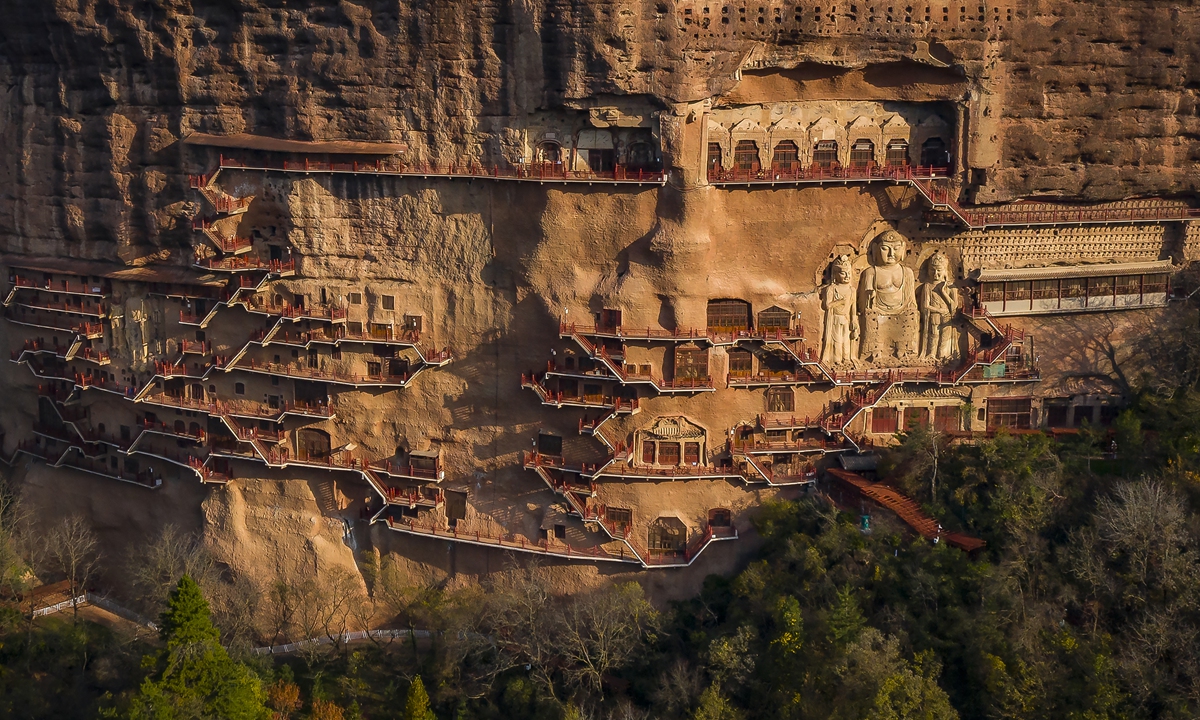
A general view of the Maiji Mountain Grottoes in Tianshui, Northwest China's Gansu Province Photo: VCG
March has barely turned the mountains of the Qinling Range green, but a small city at the foot of the Qinling Range has already exploded in popularity and ascended to the top tier in tourism for its spicy hot pot, or
malatang.
In recent days, Tianshui, a small town in Northwest China's Gansu Province, has welcomed approximately 40,000 visitors daily.
The past weekend witnessed a new peak in tourist arrivals, with over 70,000 visitors arriving from other provinces on Sunday alone, thanks to the sudden popularity gained by the local street food on social media.
Blending lifestylesAs an integral part of the Hexi Corridor, a narrow strip of land stretching along the ancient Silk Road route in Northwest China's geographic landscape, Gansu has historically served as a vital thoroughfare connecting Central Asia with China's Central Plains.
The explosion in popularity of the local spicy hot pot in Gansu is closely related to the local dietary habits.
The local northwestern Chinese cuisine primarily consists of boiled or grilled beef and mutton, as green leafy vegetables are scarcely found in Gansu or its delicacies. In places like the Hexi Corridor, if one wants to find leafy greens, the best option would be to visit a Sichuan restaurant.
However, the local spicy hot pot restaurants also provide diners with an array of vegetables to choose from and in places like Tianshui, where cuisine has been influenced by Sichuan and Chongqing traditions, the hot pot's flavor is enriched using
doubanjiang (bean sauce) and Sichuan peppercorns, adding to both meat and vegetables with a delectable spicy fragrance.
The history of Gansu's spicy hot pot is relatively short. In the 1980s and 1990s, it was merely known as spicy noodles, later evolving to include cooked ingredients, and achieve its present form.
The fervor surrounding Tianshui's spicy hot pot has also driven the development of the local cultural and tourism market.
Attractions within the small city such as the Fuxi Temple, the local museums and the Maiji Mountain Grottoes, have all experienced an early influx of tourists ahead of the peak travel season.
A staff member from the Tianshui Museum told thepaper.cn that normally, March and April were considered off-peak seasons, with only a few dozen visitors per day.
However, recently the number of daily visitors has increased to 200 to 300.
A staff member from the Maiji Mountain Grottoes also mentioned that the peak tourist season usually falls between May and October. However, in the past few days, the site has been receiving over 1,000 daily visitors.

Buddhist statues at the site Photo: VCG
Rich history Tianshui is not traditionally considered by many as a hot tourism destination, yet it is actually a hidden gem boasting many notable archaeological and cultural treasures.
Thanks to archaeological sites such as Dadiwan, the pearl of Tianshui's archeological heritage, we know that Tianshui is one of the few cities in China in which signs of human activities were found to date back an impressive 5,000 years.
In 2006, a significant excavation unearthed a plethora of relics, including pottery, stone, jade, and particularly remarkable bone artifacts, shedding light on ancient production activities within the city.
Renowned archaeologist Wang Meng emphasized that these relics serve as compelling evidence of the city's rich historical tapestry, showcasing the industrious endeavors of ancient inhabitants.
Further enriching Tianshui's heritage is its pivotal role along the ancient Silk Road during the Western Han Dynasty (206BC-AD25), as noted by archaeologist Ma Zhongli.
This historical nexus facilitated vibrant trading exchanges, contributing to the city's cultural diversity and economic prosperity.
Among Tianshui's cultural legacies stands the revered Fuxi Temple, an ancient architectural compound established during the Ming Dynasty (1368-1644).
In ancient times, the site was used for sacrificial ceremonies to worship the mythological icon Fuxi who is believed to have created Chinese culture, while nowadays it is a concrete symbol of the local culture and beliefs.
Every year around February people will worship Fuxi by lighting candles and organizing Chinese painting and calligraphic exhibitions as well as displays of cultural and creative products inspired by the ancient character.
Another emblematic cultural marvel of Tianshui is the Maiji Mountain Grottoes, boasting around 10,632 clay sculptures spanning more than 10 dynasties, originating from the latter period of the Qin Dynasty (221-206 BC).
Unlike the vividly colored murals of the Dunhuang Grottoes, the artistry of the Maiji Mountain Grottoes, particularly its sculptures, exudes a subtle grandeur, with one reaching a towering height of 16 meters.
Sculptures of the site are often characterized by solemn facial expressions and they were mainly placed upon cliffs, creating a breathtaking panorama reminiscent of grand architectural feats. The many statues at the site were originally painted, and have earned it the distinction of Asia's largest "museum" of clay sculptural art.
In essence, Tianshui stands as a testament to China's rich cultural heritage, beckoning travelers to embark on a journey of discovery through its ancient wonders and timeless traditions.